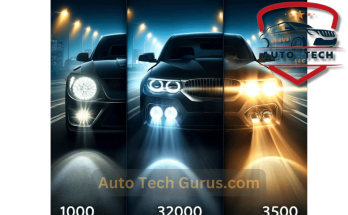Are you tired of those flickering headlights bothering you while driving? It might be utterly annoying, but it is more dangerous when
visibility on the road is concerned. But do not worry, though, since there are solutions to these problems! In this write-up, we will
investigate why headlights flicker and give you some troubleshooting tips.
Keep Flickering Headlights
First, check the wiring connections to see if loose or damaged wires could be causing this problem.
Next would be inspecting the bulb of your headlights, and should they appear old or weak, then replacing them with new ones could fix the problem.
Next, we’ll cover how one can check the voltage of your electrical system and ensure it works fine.
We will also check your alternator and battery health since these parts drive your headlights.
And finally, enlist the help of a seasoned mechanic should nothing of this nature actually work.
Let’s proceed to the following case example by putting all these steps into action and bringing light to your dark travels!
Key Takeaways
Usually, flickering headlights are caused by the loss of connections and splicing in the wiring.
Check for moisture damage on the headlight bulbs and seals, which can get damaged.
Maintain a good alternator and battery to have sound electrical system operational reliability.
Periodic inspection of wiring harnesses for their damage or wear.
Take care of Loose or Damaged Wire Connections.
Therefore, it is essential to ascertain if there are any loose wiring connections or loose wires running from your indulged headlights that are causing such a flickering effect.
Flickering headlights are irritating situations that constantly happen to many motorists. Troubleshooting such a problem is relatively easy. Thus, one does not require sophisticated mechanical aptitude to accomplish the task.
Start by examining wire connections at the back of the headlight assembly. You want to determine whether loose or corroded wires are leading to bad electrical contact. If you find anything, adjust the connection, and, for severe ones, replace it with a new wire.
Next, examine the battery’s terminals to ensure they’re tightly connected and accessible from corrodes. Flickering headlights can also be caused by loosely connecting or dirt-covered battery terminals.
Also, check the alternator belt tension. When it is too loose, voltage fluctuation can be experienced, making the lights flicker. In case of need, tighten.
If thistherea solution, one can consult an electric systems specialist and a mechanic. These have more in-depth knowledge of electric systems and sophisticated equipment capable of diagnosing and repairing more complicated wiring problems.
Remember, troubleshooting flickering headlights is not only to enhance your driving touch but also a proactive step towards the safety of yourself and others on the road.
Inspect the bulbs for burnouts.
It’s crucial to identify any issues causing the lights to flicker. Ensure the bulbs are thoroughly checked for proper function. Here are two key aspects to look for:
- Check for moisture damage, which can lead to electrical problems and flashing headlights. Look for signs of moisture or water inside the bulb housing. If you find moisture, it’s likely the bulbs need replacing.
- Ensure the rubber seals around the bulb sockets are secure and not leaking. Flickering can occur from moisture accumulating due to damaged seals.
Headlight Relay Test:
The headlight relay, an essential electrical component, powers the headlights. Flickering may be caused by a malfunctioning relay, which intermittently disrupts power. Inspect the wiring, especially at the relay’s power terminal, for any looseness or damage.
If you suspect a faulty relay, replacing it should address the flickering issues.
By checking these potential causes, you can quickly fix the issues and maintain clear visibility for night driving.
Voltage System Test:
Accurately measuring your vehicle’s electrical system voltage is critical. This will help identify possible causes of flickering headlights.
Start by assessing the system’s resistance. High resistance can hinder electric current flow, potentially leading to voltage drops and flickering headlights.
Finally, check your vehicle’s fuse box. This box contains fuses that safeguard parts of the electrical system, including the headlights. Headlights may flicker due to a poor power supply along the circuit. Remove and inspect each fuse; if it’s not transparent in the center, it may be blown. Replace any blown fuses with new ones.
If the resistance is average and all fuses are intact, it might be time to consult a professional mechanic. They use advanced methods and expertise to pinpoint the exact cause of your flickering lights.
Remember, reliable and consistent lighting systems are essential for safe driving. Take your time addressing any issues with your headlights.
Pay Attention to the Health of Your Alternator and Battery:
Maintaining an efficient charging system is vital for your vehicle’s reliable and robust electrical system, ensuring peace of mind while driving. Here are four potential causes of headlight flickering, along with tips for maintaining your electrical system:
1. Loose or Corroded Connections: Check that connections between the alternator, battery, and headlights are secure and corrosion-free. Loose connections can lead to voltage fluctuations, causing the lights to flicker.

2. Weak Alternator: If the alternator isn’t providing sufficient electricity, your vehicle’s headlights may not receive a consistent power supply. Regularly check the alternator’s output voltage to ensure it meets the manufacturer’s specifications.
3. Old or Weak Battery: A depleted or weak battery might fail to supply steady power, resulting in flickering lights. Regularly test your battery’s voltage and replace it if necessary.
Voltage Regulator Issues: The voltage regulator manages power flow through the electrical system. A malfunctioning regulator can cause intermittent power to the headlights, leading to flickering. If in doubt, have a qualified specialist assess the voltage regulator of your system.
Maintain a healthy electrical system with these steps:
- Keep the battery clean and free from corrosion.
- Avoid using electronics with just the ignition on, without the engine running.
- Regularly inspect all wiring harnesses and connectors for damage, wear, or looseness.
- Following the suggested maintenance timetable for your alternator and battery is essential.
By following these tips, you can reduce headlamp flickering and ensure a reliable electrical system for safe driving.
Seek Advice from an Expert Technician:
If unresolved issues persist with your car’s electrical system, consult a professional mechanic. Flickering headlights may have various underlying causes that require expert analysis and repair. Engage with professionals to ensure your vehicle remains safe and functional.
Finding a reliable mechanic can be challenging. When seeking recommendations, start by asking friends, family, or colleagues who have had positive experiences. Their insights can guide you to quality service providers in your area.
Additionally, research local technicians through online reviews and forums. Take time to read about other customers’ experiences to make an informed decision.
Once you have identified potential mechanics, consider visiting their shops or discussing your problem over the phone. A reputable technician should listen attentively and clearly explain their approach to diagnosing and fixing flickering headlights.
Always consult an experienced mechanic for electrical problems in your car. Promptly addressing flickering headlights is crucial to prevent further damage and ensure road safety.
Conclusion
In general, flickering headlights in vehicles are mostly associated with electrical system problems. These can be anywhere from weak or
failing batteries and alternators to loose or corroded connections that interrupt the unimpeded flow of electricity. In addition, vibrations
encountered when driving, especially on bumpy roads, are the external factors that could worsen the problem if the vital wiring or
connectors of the headlight circuit get rattled loose. Manifestations of these problems can vary, with a light occasionally flickering while
driving or becoming more noticeable at night due to contrasting light. Finally, dealing with flashing lights requires a thorough
examination of these electrical components and connections to ensure the integrity and reliability of the vehicle lighting system.
FAQ’s
Why Do My Headlights Keep Flickering While Driving?
“Headlights flickering while driving can be due to several reasons. The most common cause is a fluctuation in the vehicle’s electrical system. This can happen if your car’s battery is weak or if the alternator, which charges the battery while the car is running, is failing. Loose or corroded battery connections can also lead to flickering headlights. Additionally, a faulty headlight switch or a problem with the headlight wiring could be the culprit.”
Why Do My Headlights Keep Flickering When I Drive?
“If your headlights flicker specifically when you drive, it could indicate a problem with the car’s vibration affecting electrical connections. Loose wiring or connectors in the headlight circuit can get shaken as the car moves, causing the lights to flicker. Additionally, if the issue is more pronounced over bumps or rough roads, it could also point towards loose components in the headlight assembly itself.”
Why Do My Headlights Keep Flickering in the Middle of the Drive?
“Headlights that start to flicker in the middle of the drive could suggest an issue with the car’s charging system. As the alternator starts to wear out, it might not provide a consistent charge to the battery, leading to fluctuations in the electrical system. This inconsistency can manifest as flickering headlights. It could also be due to a temperature-related issue in the electrical system, which becomes apparent after the car has been running for a while.”
Why Do My Headlights Keep Flickering at Night?
“Headlights flickering at night could be more noticeable due to the contrast between the darkness and the light. However, the underlying cause is likely the same as flickering during the day: electrical system issues. It could also be that your headlights are set to automatic mode, and the sensors are incorrectly detecting changes in ambient light, causing the headlights to adjust unnecessarily.”
Why Do My Headlights Flicker While Driving?
“This is similar to the first question – the flickering of headlights while driving is usually due to issues within the electrical system of the car, such as a failing alternator, weak battery, loose connections, or issues with the headlight wiring or switch.”
Headlights Flickering at Idle
“If your headlights flicker only when the car is idle, it could indicate that the alternator is not producing enough power at low RPMs. This could be a sign that the alternator is beginning to fail. Another possible cause could be an issue with the idle control system of the car, causing fluctuations in electrical power.”
Why is One of My Headlights Flickering?
“If only one of your headlights is flickering, it is less likely to be a problem with the car’s overall electrical system. Instead, it could be a problem isolated to that particular headlight. Possible causes include a loose bulb, faulty wiring in that headlight’s circuit, or a problem with the headlight housing or connection.”
Headlights Flickering On and Off
“Headlights flickering on and off could indicate a more severe electrical issue. It could be due to a malfunctioning headlight relay, a failing switch, or significant fluctuations in the car’s electrical system. This could also be a sign of a dying car battery or a failing alternator that is unable to maintain a steady power supply.”



